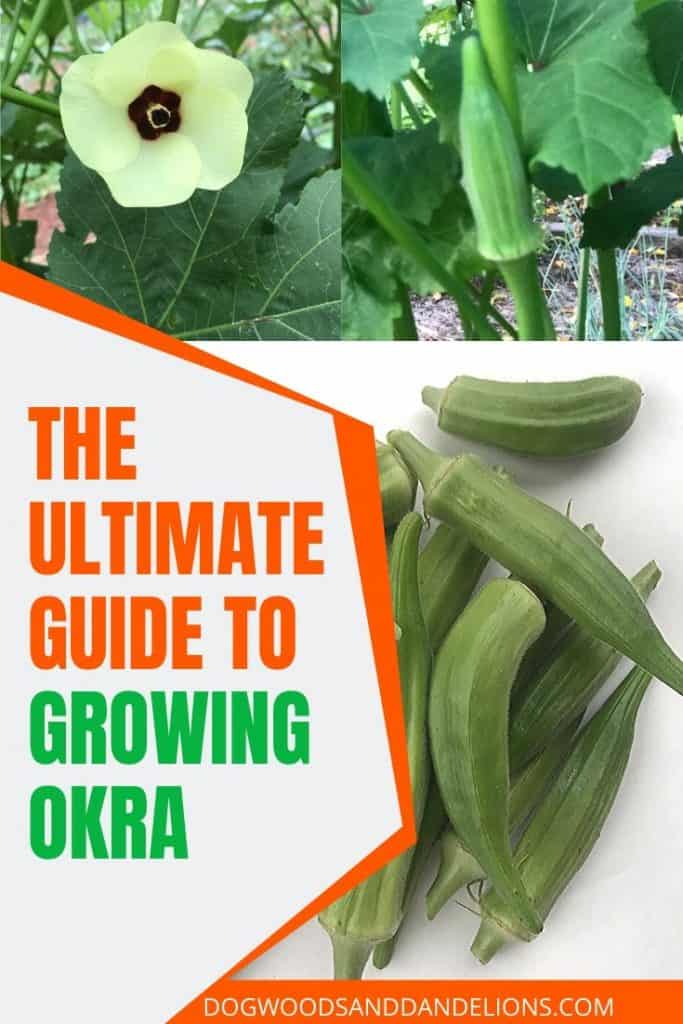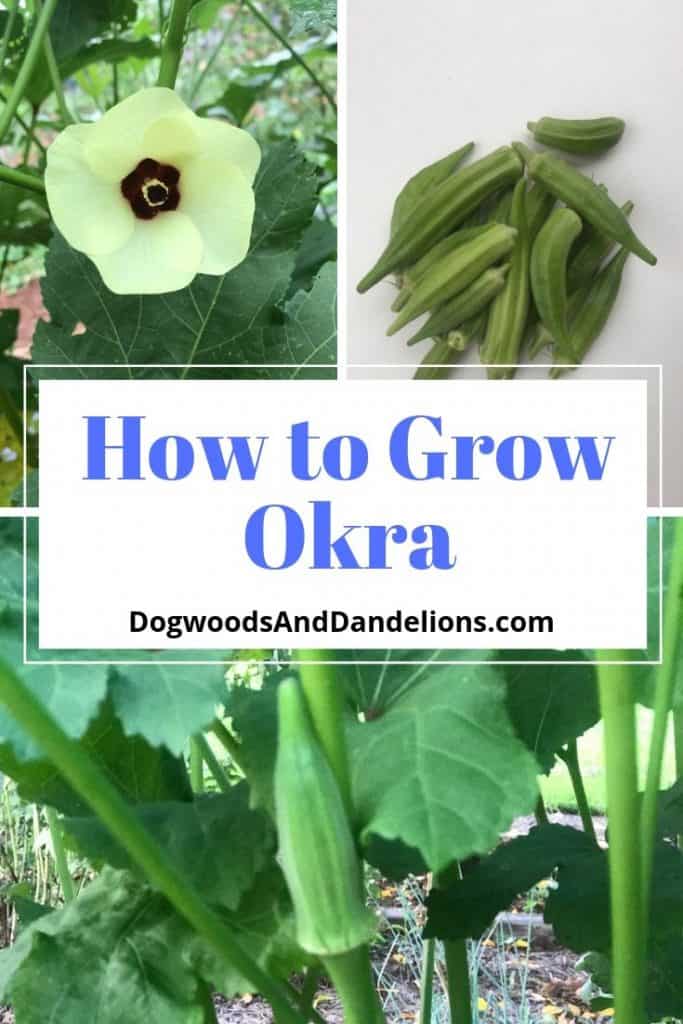How to Grow Okra
Preview: Here in the south, okra is a staple in our gardens. But do you know how to grow okra? In the post I share all the tips and tricks to help you grow the best okra this year.
Have you seen the cost of okra at the store lately? That squishy, limp okra that is already starting to mold. Wouldn’t it be nice to have fresh okra for a change? The easiest way to have the best okra is to grow it yourself. While okra is usually thought of as a southern crop, it can be successfully grown in the north if you pick the right varieties. Okra can even be grown in containers. Here’s all you need to know to grow the best okra.

Affiliate Disclosure: Please note that some of the links in this article may be affiliate links and I may receive a small commission if you purchase something through a link. It will not change your cost. As an Amazon Associate, I earn from qualifying purchases. For more information, see my disclosures page.)
How to Plant Okra
Okra likes to be grown in hot weather. It isn’t a vegetable you want to put in your garden too early in the year. You should wait until the soil temperature has warmed up to about 65 degrees before planting okra in the ground.
Okra seeds are hard so they can be slow to germinate. You can soak the seeds in warm water for several hours to hasten germination. This trick is especially good for northern gardeners with a short growing season.
Here in my zone 7 garden, I don’t usually bother soaking my seeds, but it does make a difference if you need to get the okra growing fast. Whether or not you soak the seeds, they should be planted in the ground 1/2 to 1 inch deep.
Most seed catalogs tell you to space the seeds 4-6 inches apart. Let me just say, I have never spaced my okra that way. Since I am such a big fan of wide rows, that’s how I plant my okra. I have always done this and my Dad even says that my Grandfather sowed the okra in wide rows many, many years ago long before wide row gardening was popular.
If you are planting okra in traditional rows, the rows should be 3 to 4 feet apart. However, this is one crop that does especially well in raised beds because they allow the soil to warm up sooner. Okra also does extremely well in black plastic, especially if you are trying to grow it in a cool climate.

Okra is usually a tall crop. Some varieties can grow very tall – 8+ feet. (See picture above. – My fence is 7 1/2 feet tall!) Be sure to plant it on the north side of your garden so it doesn’t shade other crops. There are shorter varieties, and I mention some of them below.
How to grow okra when you have a short growing season
If your growing season is short, choose a variety of okra that has a shorter number of days to harvest, like Red Burgundy (55 days) or Clemson Spineless (64 days). There can be a month or more difference in the time it takes to harvest okra between different varieties. For more information on days to harvest, check out my post on Understanding A Seed Catalog.
Another trick for a short growing season is to get the okra started indoors about a month before your last frost. You can soak the seeds, then plant them in individual pots indoors. To keep the seedlings from getting leggy, you will need to use a grow light.
Once your last frost date has passed you can plant the seedlings outdoors about a foot apart. However, it’s ideal to wait at least another two weeks BEYOND the last frost date, since okra doesn’t like cold temperatures.
Handle the transplants gently when planting as they have fragile roots that don’t like to be disturbed. Raised beds and/or black plastic will help ensure the roots stay warm when growing okra in cooler climates.

How to Harvest Okra
Okra is usually ready to harvest about 2 months after planting. Once you see the yellow, hibiscus-like blooms, the pods are not far behind. The time from flower to actually harvesting the pods is usually only 3-4 days.
Okra pods can get tough in a hurry, so it is best to pick them when they are small, about 3-4 inches long. Okra needs to be picked every other day. If you find old pods, pick them anyway and add them to the compost pile. Otherwise, the plants will slow production of pods.
When picking okra, you should wear gloves and long sleeves. Many varieties contain spines that will cause you to itch and burn. This does not mean you are allergic to it!
However, even the spineless varieties make me itch. It sure hasn’t stopped me from growing okra though! I just always wear gloves when picking. Cutting the pods off the plant instead of pulling them off, will ensure you don’t damage the plant and open up areas for disease.
Okra does not keep long when stored (That’s why it always looks so bad at the store.) so try to cook and eat it the same day or preserve it. It will keep for a day or two in the refrigerator, but after two days the quality starts to decline rapidly.
I recently read an article about freezing okra whole. I have never tried it this way, but you can bet I will this year. Supposedly, once you thaw it, you can use it any way you would use fresh okra. Around here our favorite way to eat okra is fried (big surprise, right?) so I’ll definitely test this out and report back.
Pests and Diseases
Okra is not usually bothered by too many pests. The biggest pests that bother my okra have been stink bugs and Japanese beetles. Usually I hand pick them, which is my preferred method of pest control.
The other insect that seems to like okra as much as we do is ants. They can often be found in the flowers of the okra, but sometimes they will eat the pods themselves, usually where the stem end meets the okra pod. I typically let the ants have a few pods because I don’t like spraying chemicals in my garden. They usually don’t ruin my entire crop.
Favorite Varieties
Clemson Spineless is my favorite variety of okra, and is usually the only variety I grow. However, this year, I’m hoping to try a burgundy variety if I can still find some seed. Clemson Spineless was an All American award winner back in 1939 and is still a great choice today.
Since it has no spines so it is easy to pick, however the plants still irritate my hands and arms if I don’t wear gloves and long sleeves. I did have to laugh when one seed catalog stated that Clemson Spineless plants only grew about 3 feet tall. I’ve had some grow over 8 feet tall in my garden!
If you want to grow okra in a container, the best variety would be Jambalaya. Jambalaya is also the best variety for northern gardeners. These plants are compact and the pods are ready earlier than most other varieties.
There are also several red varieties of okra on the market today. Two popular ones are Candlefire and Red Burgundy. Candlefire is unusual in that the pods are smooth whereas most other okra has ribbed pods. This variety is easy to pick as the red pods stand out on the plant.
On the other hand, the pods of Red Burgundy okra are also red, but so are the stems, the flowers, and even parts of the leaves. A great ornamental plant in the garden, the pods of this variety are also edible.

Ways to Cook Okra
There are many ways to cook okra, some much healthier than others. Here in the south, fried okra is a favorite. I have also learned how to stir fry it so it tastes (almost) as good as traditional fried okra. Okra is one of the main ingredients found in Gumbo, a Louisiana staple, containing tomatoes, peppers, onions, celery, and seafood and/or sausage all in a well-seasoned broth. Okra can also be pickled for a delicious side dish.
What is your favorite way to prepare okra? I would love to learn other ways to prepare it since we grow quite a bit around here. Leave a comment and tell me your favorite okra recipe.


I’ll be growing okra for the first time next year in Zone 7b. I hope it does well. I’ve got a good sunny location for it
It should do well for you. And you won’t believe how good it tastes homegrown.
I grew up in California. My mom had a huge garden and put Okra in soup. It’s delicious.
That does sound really good. I might just try that since I have a good bit of homegrown okra in the freezer right now.
I like to freeze okra. If you toss it with just the cornmeal (and maybe other preferred spices) after slicing, spread it out on a cookie sheet, freeze it and then put it in a baggie. Keeps it separated and maintains the flavor
I have frozen okra this way too and it is delicious. Do you fry yours or how do you prepare it? I’ve only ever fried mine but would love a healthier way to serve it.
my favorite way to eat okra is raw.
Wow! I’ve not heard of many people that eat okra raw. I’m glad you enjoy it!